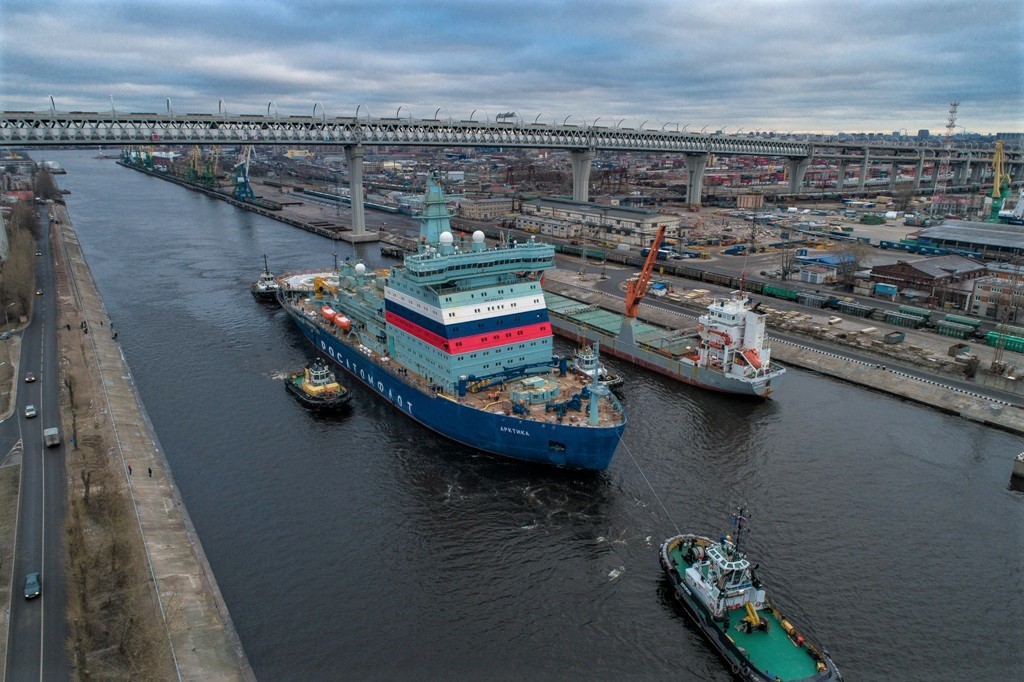By TASS Russian news agency
The icebreaker has to become operational in 2027 when the economic crisis is likely to end and the competition of the global players for Polar resources and the shortest Northern Sea Route from the Pacific to the Atlantic would resume.
Historically, Russia enjoys a priority in the Arctic development, but other countries may ignore it if there is nothing to back the claim. The Russian Defense Ministry copes with the task and is rebuilding military infrastructure in the Arctic. Another argument is a powerful icebreaker fleet to ensure full-scale activities in the Arctic in conditions of global warming.
An unequalled group of icebreakers has ensured Russian economic interests in Arctic latitudes until recently. The United States and China announced the construction of icebreakers and ice-class vessels, including warships for Arctic operations.
Iceberg Design Bureau produced the project of a new Russian nuclear icebreaker. It will be powered by RITM-400 reactor created by OKBM Africantov bureau in Nizhny Novgorod. It is a leading enterprise of Rosatom nuclear corporation.
Project 10510 icebreaker will lead big-displacement vessels with a deadweight of over 100000 tons and a width of over 50 meters along the Northern Sea Route year-round. The propulsion is provided by four four-blade fixed-pitch propellers. The Leader can break 4.3-meter thick ice at the minimal stable speed of 1.5-2 knots. The speed in 2-meter thick ice is 12 knots. The food stocks allow the icebreaker to sail for eight months. The crew comprises 127 men. The life cycle is 40 years, the displacement is close to 71380 tons.
The Leader is the first icebreaker in the world capable of operating in the Northern Sea Route year-round. Rosatom plans to build three icebreakers by 2033. The Industry and Trade Ministry estimated the first Leader to cost 127.5 billion rubles. The construction of two other icebreakers is to be jointly financed by the federal budget and Rosatom. Concession is another option, as all Arctic developers, including private enterprise, are interested in the protection of their Arctic interests, expert Vasily Dandykin said.

The Leader is to be the most powerful vessel of the class in the world. Besides, three icebreakers of project 22220 are being built in St. Petersburg and the lead one is undergoing trials. They belong to the third generation. The fourth-generation Leader does not fear 4-meter thick ice along the whole Northern Sea Route which will be in demand after the crisis. It is the shortest and cheapest way from Asia to Europe.
“It is clear that the Leader and other icebreakers will lead not only tankers and container carriers along the Northern Sea Route. The year-round navigation gives the Defense Ministry an opportunity to redeploy forces from the west to the east and back in a period of threat. It is important on the background of growing military ambitions of the United States and NATO. The Leader icebreaker is thus a major argument for Arctic claims,” Dandykin said.
Expert Vasily Dandykin
Much depends on the shipbuilding industry which lost a lot after the Soviet collapse and is experiencing hard times. However, the revival trend has shaped out. The Arktika icebreaker has to begin operations shortly followed by the Sibir and the Ural icebreakers which have been floated. The Yamal and the 50 Years of Victory icebreakers operate in Arctic latitudes. The Ilya Muromets diesel-electric icebreaker of project 21180 and the Ivan Papanin ice-class escort ship of project 23550 were built for the Navy.
The construction of the Leader icebreaker by Zvezda Shipyard means the enterprise is capable of building supertankers and aircraft carriers, the Zvezda said.






